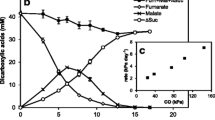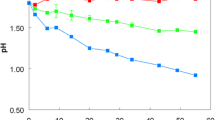Abstract
Seven strains of aerobic carbon monoxide-oxidizing bacteria (“carboxydebacteria”) when growing on CO as sole source of carbon and energy had doubling times which ranged from 12–42 h. The activity profiles obtained after discontinuous sucrose density gradient centrifugation indicated that the CO-oxidizing enzymes are soluble and the hydrogenases are membrane-bound in all strains examined. The CO-oxidizing enzymes of Pseudomonas carboxydohydrogena, Pseudomonas carboxydoflava, Comamonas compransoris, and the so far unidentified strains OM2, OM3, and OM4 had a molecular weight of 230,000; that of Achromobacter carboxydus amounted to 170,000. The molecular weights of the CO-oxidizing and H2-oxidizing enzymes turned out to be identical. The cell sonicates were shown to catalyze the oxidation of both CO and H2 with methylene blue, thionine, phenazine methosulfate, toluylene blue, dichlorophenolindophenol, cytochrome c or ferricyanide as electron acceptors. Methyl viologen, benzyl viologen, FAD+, FMN+, and NAD(P)+ were not reduced. The spectrum of electron acceptors was identical for all strains tested. Neither free formate, hydrogen nor oxygen gas were involved in the CO-oxidation reaction. Methylene blue was reduced by CO at a 1:1 molar ratio. The results indicate that CO-oxidation by carboxydobacteria is catalyzed by identical or similar enzymes and that the reaction obeys the equation CO+H2O→CO2+2H++2e- as previously shown for Pseudomonas carboxydovorans.
Similar content being viewed by others
References
Bergmeyer HU (1955) Zur Messung von Katalase-Aktivitäten. Biochem Z 327:255–258
Boehringer Mannheim Corporation (1973) Boehringer Informationen. Boehringer Mannheim Corporation, Manuheim
Bradford MM (1976) A rapid and sensitive method for the quantitation of microgram quantities of protein, utilizing the principle of protein dye binding. Anal Biochem 72:248–254
Daniels L, Fuchs G, Thauer RK, Zeikus JG (1977) Carbon monoxide oxidation by methanogenic bacteria. J Bacteriol 132:118–126
Gitlitz PH, Krasnn AI (1975) Structural and catalytic properties of hydrogenase from Chromatium. Biochemistry 14:2561–2568
La Rivière JWM (1958) On the microbial metabolism of the tartaric acid isomens. Ph.D. Thesis, University of Delft, The Netherlands
Lax E (1967) D'Ans-Lax: Taschenbuch für Chemiker. Vol 1. Springer, Berlin Heidelberg New York
Martin RG, Ames BN (1961) A method for determining the sedimentation behaviour of enzymes: Application to protein mixtures. J Biol Chem 236:1372–1379
Meyer O (1978) Kohlenmonoxidoxidation und-assimilation durch das aerobe Wasserstoffbakterium Pseudomonas carboxydovorans. Ph.D. Thesis, University of Göttingen, Germany
Meyer O, Schlegel HG (1978) Reisolation of the carbon monoxide utilizing hydrogen bacterium Pseudomonas carboxydovorans (Kistner) comb. nov. Arch Microbiol 118:35–43
Meyer O, Schlegel HG (1979) Oxidation of carbon monoxide in cell extracts of Pseudomonas carboxydovorans. J Bacteriol 137:811–817
Meyer O, Schlegel HG (1980) Carbon monoxide: methylene blue oxidoreductase from Pseudomonas carboxydovorans. J. Bacteriol 141:74–80
Meyer O, Lalucat J, Schlegel HG (1980) Pseudomonas carboxydohydrogena (Sanjieva and Zavarzin) comb. nov., a monotrichous, non-budding, strictly aerobic, carbon monoxide-utilizing hydrogen bacterium, previously assigned to the genus Seliberia. Int J Syst Bacteriol 30:189–195
Nozhevnikova AN, Savelieva ND (1972) Autotrophic assimilation of carbon dioxide by a carbon monoxide oxidizing bacterium. Mikrobiologiya 41:939–946
Nozhevnikova AN, Zavarzin GA (1974) On the taxonomy of CO-oxidizing gram negative bacteria. Izvestiya Akad Nauk SSSR, Ser Biol 3:436–440
Sanjieva EU, Zavarzin GA (1971) Oxidation of carbon monoxide by Seliberia carboxydohydrogena. Dokl Akad Nauk SSSR 196:956–958
Schlegel HG, Schneider K (1978) Distribution and physiological role of hydrogenases in microorganisms. In: Schlegel HG, Schneider K (eds) Hydrogenases: Their catalytic activity, structure and function. E. Goltze KG, Göttingen, p 15–44
Schneider K, Schlegel HG (1977) Localization and stability of hydrogenases from aerobic hydrogen bacteria. Arch Microbiol 112:229–238
Stegemann H (1972) Apparatur zur thermokonstanten Elektrophorese oder Fokussierung und ihre Zusatzteile. Z Analyt Chem 261:388–391
Veeger C, der Vartanian DV, Zeylemaker WP (1969) Succinate dehydrogenase. In: Colowick SP, Kaplan NO (eds) Methods in enzymology 13. Academic Press, New York London
Zavarzin GA, Nozhevnikova AN (1977) Aerobic carboxydobacteria. Microb Ecol 3:305–326
Author information
Authors and Affiliations
Additional information
Dedicated to Otto Kandler remembering almost three decades of enjoyable cooperation
Rights and permissions
About this article
Cite this article
Cypionka, H., Meyer, O. & Schlegel, H.G. Physiological characteristics of various species of strains of carboxydobacteria. Arch. Microbiol. 127, 301–307 (1980). https://doi.org/10.1007/BF00427208
Received:
Accepted:
Issue Date:
DOI: https://doi.org/10.1007/BF00427208




